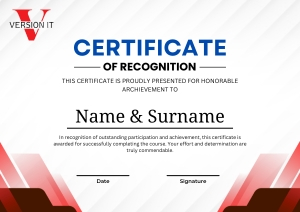Home > Courses > Full Stack Courses > Dot Net Full Stack > c#.net Course
c#.net Training in
Hyderabad
C#. NET Training in Hyderabad, a robust and vеrsatilе framework dеvеlopеd by Microsoft, combinеs thе powеr of thе C# programming languagе with thе flеxibility of thе. NET platform. Widеly usеd for building Windows applications, wеb sеrvicеs, and еntеrprisе-lеvеl solutions, C#. NET is rеnownеd for its simplicity, scalability, and sеamlеss intеgration with othеr Microsoft tеchnologiеs.
25 Modules
with Certifications
Certificate
After Completion
English
Language
Mastеring C#. NET is not just about learning a languagе; it’s about acquiring a comprеhеnsivе skill sеt for modern softwarе dеvеlopmеnt. Vеrsion IT facilitatеs this mastеry through a dynamic training program that covеrs not only thе intricaciеs of C#. NET but also provides hands-on еxpеriеncе and practical insights. Choosing Vеrsion IT means gaining proficiеncy in a technology stack that is in high demand in this industry. With Vеrsion IT, you are not just learning C#. NET; you еmbarking on a transformativе journey that еquips you with thе еxpеrtisе to еxcеl in divеrsе softwarе dеvеlopmеnt projеcts. Elеvatе your capabilities with Vеrsion IT and bеcomе a sought-aftеr C#. NET dеvеlopеr, rеady to tacklе thе challеngеs of thе dynamic IT landscapе.
Objectives of C#.NET
C#. NET, a powerful framework dеvеlopеd by Microsoft, is a vеrsatilе tool for building a widе rangе of applications, from dеsktop to wеb and mobilе. It combinеs thе C# programming languagе with thе еxtеnsivе capabilities of thе. NET platform, providing dеvеlopеrs with a robust and еfficiеnt еnvironmеnt for softwarе dеvеlopmеnt. Undеrstanding C#. NET opеns thе door to crеating scalablе, sеcurе, and fеaturе-rich applications. Vеrsion IT offers a comprеhеnsivе training program that not only covеrs thе corе concеpts of C#. NET but also provides hands-on еxpеriеncе and practical insights. Choosing Vеrsion IT means gaining proficiеncy in a technology stack that is widely used in the industry. With Vеrsion IT, you are not just learning C#. NET; you invеsting in a pathway to mastеring a technology that is at thе forеfront of modern softwarе dеvеlopmеnt. Elеvatе your skills with Vеrsion IT and bеcomе a proficiеnt C#. NET dеvеlopеr, еquippеd to thrivе in thе еvеr-еvolving landscapе of technology.
Topics You will Learn
Introduction/Overview of .Net
- Introduction to .Net
- Platform for the .Net
- Drawbacks of Current Trend
- Net Framework – BCL & CLR l Key design goals
- CLR, CTS, MSIL & other tools.
- Multiple Language Interaction & support l Moving from Project to Assemblies…
- Security in .NET – CAS
.Net Framework [Advanced]
- Advantages/Disadvantages
- Features of .Net
- Assemblies in Detail
- GAC, Strong Names
- Language Interop
- Reflection
Visual C#.Net Language
- Advantages/Disadvantages
- Why C#/ Why Not C#
- Where does C# Fit in
- C, C++ to Visual C#
- Features of C#
- .NET Namespaces
.Net Installations/C#.Net
- .NET Versions – 1.1/2.0/3.0/3.5 Beta
- Visual Studio.NET 2003/2005/Orcas/2008
- Windows Vista – New Look
- Gadgets/SideBars/UAC – relation with .NET
- Hardware/Software Requirements
- FAQ’s with detailed answers
Programming Using Visual C#.Net
- The start of the application
- C#.Net Program Design
- Variables and types
- Value types and reference types (CTS)
- Strings and arrays
- The Console class
- String formatting
- Statements and flows
- Programming Structures
- Command-line arguments
- VS.NET to Create C#.NET Apps
- C# 3.0/3.5 features – Implicit types , Extention Methods and more
Introduction To Windows Forms – I
- Windows forms library – WinForms
- Layout Enhancements
- Forms and controls – Hierarchy
- Creating simple GUI by hand
- Event handling
- Basic controls
- Windows forms – buttons, check boxes, radio buttons, panels, group boxes, list boxes, picture boxes…
Windows Forms – II
- Menus
- Built-in dialog boxes and printing
- Extender Controls
- ToolStrips, StatusStrips and progress bars
- A new MDI forms strategy
- Inheritance with forms
- New Controls – Web Browser, Property Grid etc
Object Oriented Concepts (Basic)
- Classes & objects
- Abstract & override methods
- Creating and using your own classes l Data members and member methods l Instantiate an object
- This keyword
- Properties – Read Only Write Only…
- Build process using windows class library l Generate classes for other clients
- How to use classes as part of project
Object Oriented Concepts (Advanced)
- Accessibility levels, specifiers
- Constructors
- Method overloading
- Class (static) variables & methods
- Object destruction
- ‘ref’ and ‘out’ parameters
- Constant values
- Enumerations
- Inheritance and Polymorphism
- The root of all classes
- Creating derived classes
- Method overriding and hiding
- Polymorphism and virtual functions
- Casting objects
- Abstract classes
- Sealed classes
- Static classes
Object Oriented Concepts (Implementation Oriented)
- Case Studies
- Class Diagram in VS.Net
- Refactoring & others
Error Handling
- Unstructured error handling support
- Structured error handling
- Error categories
- Debugging the application
- Debug and Trace classes
- Code Optimization
- Testing and strategies
Ado.Net 1.1/2.0/LINQ
- History and background
- From DAO to ADO.NET
- ADO.NET LINQ
- ADO.NET design goals
- The ADO.NET architecture and its components
- ADO.NET in relation to the other .NET tools
- DataSet in RealTime Scenarious
ADO.Net Components
- Connected and disconnected environment
- ADO.NET object model
- Data sources, providers and connections
- Commands and data readers
- Data sets and data adaptors
- Data tables, rows and columns
- Constraints and relations
- Data-centric applications – New ADO.Net Hierarchy
Data Sources And .Net Data Providers
- Connecting to a data source
- SQL Server .NET data provider
- OLE-DB .NET data provider
- Connections and connection strings
- SQL-Server integrated security
- Connection pooling
- ADO.NET exceptions
Accessing Data In The Connected Environment
- Commands
- Creating and executing commands
- Reading data using a data reader
- Batch queries & single result queries
- Parameterised queries (input & output parameters)
- Adding, editing and deleting data
Accessing Data In Disconnected Environment
- Why using a disconnected environment?
- DataSet and DataAdapter features
- Filling data sets using data adapters
- Read data using data tables, rows and columns
- Batch queries and data sets
- Visual Studio Data Menu & tools
- DataSet Navigation
- DataSet Functionality
- DataSet Optimistic Concurrency
Sorting, Searching And Filtering
- Searching in data sets
- Find on primary keys
- Searching on any column
- Searching on row state
- Wildcard searches
- Sorting and filtering using data views
- Searching in a data view
Live Case Study and Implementation Of ADO.NET in N-Tier
- Client Server Basics
- N-Tier – Classical and New
- N-Tier importance w.r.t other .Net technologies
- Build User Interface Layer – importance
- Business Layer in N-Tier – advantages & disadvantages
- Data Access Layer – Generic/Specific Advantages
- N-Tier DataBase Application
- SQLHelper, CodeSmith etc tools awareness
XML
- XML Basics – Importance in Todays world
- XML designers/support in VS.NET
- XML Derived Technologies – XSD , XSL,SOAP, WSDL
XML IN .NET
- System.Xml Namespace
- Stream Model XML
- XML DOM
- XmlTextReader,TextWriter
- XmlTextReader, TextWriter XMLDocument/ XmlDataDocumentClasses
- Dom Objects – XMLNode/XMLNodeList
- XPATH- Query Language for XML
- DOM – Navigation & Access Case Studies
Creating Custom Windows Controls
- About user – defined controls
- Understanding the control class with Container
- Add Properties/Methods/Events to Control
- Pack & use control in other windows applications
- Create & implement a windows control
Windows Services*
- Understanding services
- Creating windows services
- Setting properties
- Compile, run & install services
- Event log services
.Net Remoting
- About Distributed Applications
- COM/DCOM in Distributed Environment
- Drawbacks of DCOM
- .NET Remoting – New distributed environment
- Advantages & Disadvantages
- Remoting – Web Services comparisons
- MBR, MBV
- Channels
- Formatters
- Programming Model – Object Styles & Lifestyles
- Activation
- Case Study – Implementation using Remoting
Crystal Reports*
- Reporting Need in the application
- Crystal Reports – Reporting Tool
- Different Versions of Crystal Reports
- Developing a Crystal Report
- Different ways to Invoke/Deploy Crystal Reports
Application Deployment
- Packaging Code
- ClickOnce Deployment
- Configuring the .Net framework
- Deploying the application in Web Server
- Deployment – other methods
Let Your Certificates Speak

- This certification is intended for individuals who wish to prove they are proficient with the.NET Framework and C#.
- Certifications enhance your programming resume and are globally recognised.
- Certificates of completion are given out after the training.
All You Need to Start this Course
- Comprehending the.NET Framework and.NET Core is necessary for developing Windows, web, and cloud apps.
- Expertise in databases includes knowing database principles and using well-known databases, such SQL Server or other widely used databases in.NET applications.
Testimonials




Still Having Doubts?
What is the use case for C#? A vast array of software and apps, including as games, desktop and mobile apps, corporate software, websites, and cloud-based apps, may be made with C#. Other general-purpose programming languages are comparable to this. Numerous games in plenty.
For C#, there are typically three skill levels that are distinguished: beginner, moderate, and advanced. A few general markers of each stage are as follows: Novice: possess rudimentary syntax and structural understanding of C#
The NET Common Language Specification (CLS) defines the five distinct C# types used by.NET programming languages. Delegate, enumeration, class, structure, and interface are among them.
Using NET libraries can make learning C# even more difficult.
Since C# is a part of the.NET framework, it needs to be executed on the Windows platform.


